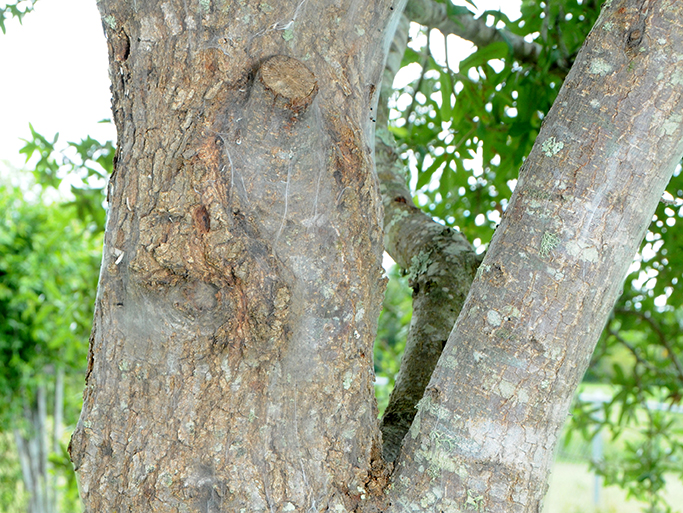Web-spinning Barklouse, Vol. 4, No. 27

Web-spinning Barklouse
Archipsocus nomas
Order: Psocoptera
Family: Archipsocidae
Janie was sitting on the back deck drinking her first cup of coffee when she saw it. Something was wrong with the live oaks. All three of ‘em! She put down her cup, slipped out of those fuzzy, zebra-striped slippers and into her garden clogs, and trotted into the backyard for a closer look. The trunks and larger limbs were completely encased in some sort of white silk-like material—all the way around the tree and all the way up the trunk! Her first thought was spiders. Big ones! Practical jokers was the next thing to come to mind. It was getting close to Halloween. Maybe Mary Beth was finally getting back at her for that time …? Janie didn’t have her contacts in yet, so she could not see the brown, aphid-sized insects that were the real cause of the problem.
This was the work of web-spinning barklice, a phenomenon only seen in the southern portion of the state, primarily in Coastal counties, and most often on live oaks, but occasionally on other hardwoods. Barklice feed on algae, lichen, fungi and similar organic materials that occur on tree bark and other plant surfaces, causing no harm to the plants that host them. Many species of barklice occur in the state, and several other species spin protective coverings of silk webbing over themselves, but the web-spinning bark louse is the only species that produces such dramatic amounts of webbing. Web-spinning barklice are not social insects like ants and bees, but they are gregarious, and the sheets of webbing they produce provide protection from predators and help maintain a more humid and favorable environment for the entire community. Like most other insects, web-spinning barklice are more abundant some years than others.
What to do about them? Get a magnifying glass and see if you can spot some of the insects that produce this webbing. If the layer of webbing is thin enough, you can look directly through it. Otherwise, you may have to carefully rake away a section of webbing. Look for small brown, aphid-sized insects hidden among crevices in the bark. The immatures will be wingless, but adults have wings that they carry folded, tent-like over their bodies. Other than exercising your curiosity in this way, there is nothing else that really needs to be done about webbing barklice. They, along with the webbing they produce, are harmless to trees, and the webbing will soon weather away as winter approaches.
Blake Layton, Extension Entomology Specialist, Mississippi State University Extension Service.
The information given here is for educational purposes only. Always read and follow current label directions. Specific commercial products are mentioned as examples only and reference to specific products or trade names is made with the understanding that no discrimination is intended to other products that may also be suitable and appropriately labeled.

